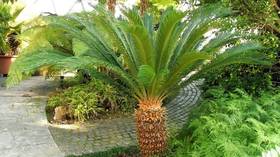Jurassic lark: Ancient ‘living fossil’ plants grow again in UK after 60 MILLION YEARS (PHOTO)

British botanists are celebrating the remarkable resurrection of a primitive tree that ruled Earth’s plant kingdom eons ago. For the first time in 60 million years, ‘Cycas revoluta’ cones are growing outdoors.
The species, native to Japan and believed to be pollinated by beetles, was widespread all over Earth during the Jurassic period, when the planet’s climate had naturally high levels of carbon dioxide. The species has changed remarkably little over the interim, hence them being dubbed ‘living fossils’.
Now, in the Ventnor Botanic Garden on the Isle of Wight, both a male and female cycad plant are growing. The male and female cones are quite far apart in the botanic gardens so the pollen must be transferred by hand.
The first male cycad cone began growing seven years ago, but the first female cone only appeared earlier this month, which means botanists now have the opportunity to generate seeds and thus create new plants the old-fashioned way.
Also on rt.com Doomed dinosaur’s last meal reveals previously unknown lizard species (IMAGE)“It is a strong indicator of climate change being shown, not from empirical evidence from the scientists but by plants,”said Chris Kidd, the curator of Ventnor Botanic Gardens, of the plant’s return.
Kidd cites last summer’s heatwave and this year’s record-breaking temperatures as possible contributing factors in the reemergence of the plant: “Thirty years ago we couldn’t have grown them.”
Think your friends would be interested? Share this story!














